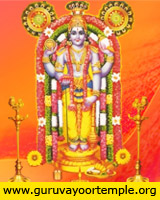
 The Pilgrimage
The Pilgrimage Ancient Hindu sages believed that periodic fasts or vrithams purify the human mind and body. By adhering to an austere way of life and observing tapas in body, mind and speech, man transcends his earthly limitations and changes for the better, so says the Bhagavad Gita. A devotee aspiring for a darshan of Lord Ayyappan has to be pure both mentally and physically and for this, he is expected to observe a mandatory fast (vritham) of 41 days that usually begins on the first day of the Malayalam month of Vrischikam in mid November. A pilgrim who is on his maiden trip to Sabarimala is called a Kanni Ayyapppan.
The 41-days fast highlights the significance of austerity and abstinence in the lives of those seeking a complete merger with the Ultimate. A devotee has to abide by several regulations and dictates if he is to mount the pathinettu padikal and enter the temple on Sabarimala.
The devotee embarks on the 41-day vritham after he gains permission from his parents and Guru. Next, an auspicious day is fixed for the commencement of the vritham and on the eve of the said date, he offers poojas to the family deity and makes a holy knot with yellow cloth containing 1.25 currency units and presents it to the family deity thereby gaining his/her approval to begin the vritham.
The Sacred Mala
As a prelude to the actual pilgrimage, the aspirant wears a beaded mala/garland usually of tulsi or rudraksham to highlight his renunciation of material temptations. Majority of the devotees begin wearing the mala from the first day of Vrishchikam. Wearing the garland on a Saturday or on the day of asterism of Uthram, just prior to the first day of Vrishchikam is considered auspicious, for it is held that Dharma Shastha or Lord Ayyappan was born on first Vrishchikam on a Saturday, the asterism being Uthram. The occurrence of these three features on the same day is a rare phenomenon. Hence any one among the trio is chosen. As a rule the devotee receives his mala from a Guruswami, one who has been to Sabarimala repeatedly several times. The ritual is ordinarily conducted in the precincts of a temple or any other holy place.
As he wears the holy mala around his neck, the pilgrim swears total allegiance to Lord Ayyappan with whom he identifies himself completely. He surrenders his thoughts, words and deeds to the powerful deity and begins to lead the austere life of an ascetic.
On the first day of the fast, the pilgrim awakes early, bathes and offers poojas to the family god, navagrahas (the nine planets) and the holy mala. He then proceeds to the temple with his Guru from whom he receives the mala amidst the chanting of saranams.
Like Lord Ayyappan, the renunciant, the devotee is expected to shun all social activities and immerse himself in prayers, poojas, bajans, visits to the temples, cleaning temples, feeding the poor, attending to the poor/sick and listening to spiritual lectures. Strictly celibate, he consumes only satvic food and is forbidden from having meat, intoxicants like alcoholic beverages, drugs and betel leaves, and smoking.
Taking bath in the pre-dawn hours, regular application of vibhooti, sandalwood paste followed by meditation and singing songs about Lord Ayyappan become his part of his daily routine for 41 days. No shaving is allowed and the devotee prays to Dharma Shastha by chanting his name at least 108 times. He refrains from hurting anybody either physically or verbally and identifies other Ayyappa devotees with the Lord himself. When somebody undertakes the 41-day fast, he must go about it quietly without much ado so as not to cause any inconvenience to his family.
The Ayyappa swami does not oil his hair or body and always carries with him a tulsi leaf to ward off evil and temptations. He sleeps not on the bed and uses no footwear to protect his feet.
Aazhi pooja/Vellamkudi
The Aazhi pooja is an important event associated with the pilgrimage to Sabarimala. It is more or less a celebration that symbolizes the attainment of a renunciant's frame of mind. The pooja is performed on an auspicious day before the holy trek actually begins. This ritual is also called Vellamkudi, Daham Veppu or Padukka. Vellamkudi in the local Malayalam language means the act of drinking water and Daham Veppu, quenching one's thirst. Human beings long for satisfaction of their various material desires as a result of their undue attachment to the body. Such unquenched thirsts are impediments in their quest for God-realization; once they are removed, the devotee experiences supreme bliss. By leading a spiritually oriented life for several days, the Ayyappa bhaktha attains a considerable degree of purification, both mentally and physically and this culminates in Aazhi pooja.
A special pandal is erected for this purpose. Fuels for aazhi (fire blaze) are stored in stacks in front of the pandal and camphor is used to start the fire. As the aazhi blazes and tongues of flames go higher, the worshippers circumambulate it chanting 'Swamiye Saranam Ayyappa.' Rice flakes, parched rice and pieces of coconut are thrown regularly into the raging fire. The flames are believed to be Lord Ayyappan himself and the articles hurled into the fire represent worldly desires which are annihilated by Lord Ayyappan who is the embodiment of true wisdom. Sometimes, the Ayyappas, ecstatic and oblivious to their surroundings walk on the aazhi, out of devotional fervour.
Soon afterwards, poojas are performed and camphor burnt. Burning of camphor leaves no traces behind; it therefore, connotes total destruction of the meaningless longings of the aspirant.
Kettunira
Another important aspect of pilgrimage to Sabarimala is the preparation of the travel kit which is termed irumudi kettu. Only those who observe the 41-day vritham are allowed to carry it and without the irumudi, the devotee cannot climb the pathinettaam padi at the Sannidhanam. The bag is evocative of Lord Ayyappan's trip to the forest for tigress' milk; it has twin pockets, the Munmudi (the front portion) and the Pinmudi (the rear pouch), in addition to an opening in the middle. The pooja articles and offerings to Lord Ayyappan are placed in the front bag while the pilgrim's personal belongings are packed in the rear pouch.
Irumudi binds the worshipper with the worshipped. It is such a strong tie that the devotee and the devoted are no longer two different entities but a single whole. Munmudi comprises Mudra bags, usually 2 or 3 in number, which hold items for vazhipadu (offering) at the Sannidhanam like:
Coconut filled with ghee for Abhishekam (also called Neithenga), 2 to 4 coconuts (vidalai thengai), Beetel leaves, beetel nut, coins (kanikkappanam), Jaggery (achuvellam), cashewnuts, raisins, dry ginger, poha (thin & thick variety)Cardamoms, dates, honey, avil ( beaten rice), kadhi chakkar, Dried turmeric, turmeric powder, blouse piece, kumkum, vibhooti, sandal paste Sambarani, camphor, agarbathi (incense stick), rosewater,lemon, rice & dal TTT
The front portion of the Irumudi represents the good acts of the devotee and the rear one his sins.
To prepare the ghee coconut (neithenga) for abhishekam, a medium sized coconut is selected. Its outer shell is cleaned and polished using a polishing paper. A hole is made in one eye of the coconut with a pointed instrument to empty the water inside; the opening is then closed with a cork of appropriate size. It is later, filled with ghee during kettunira. The vidalai thenga are broken at regular intervals during the actual pilgrimage - one each at Erumeli and Sharam Kutti and two upon pathinettam padi (the sacred 18 steps at Sabarimala). The jaggery, cashewnuts, raisins, cardamom, honey and dates are used to make Panchamrutam for the Neivedya; with jaggery, dry ginger and cardamom, another neivedya termed panagam is also prepared.
Articles for the pilgrim's personal use are kept in the pinmudi; these include items for use from the day of commencement of the journey after Kettunira till return. The second bag contains some snacks and other ingredients such as rice and pulses for food that's prepared during the journey.
It is the Guruswami who prepares the irumudikettu and places it on the head of the devotee. The journey to the Ayyappa temple on Sabarimala is invariably conducted in groups. The traditional route to the shrine covers Erumeli, Kalaketti, Azhutha, Karimala, Pampa and eventually Sabarimala.
The Ayyappa swami who ascends the Patinettampadi 18 times plants a coconut sapling on Sabarimala.





